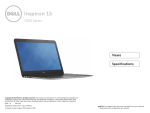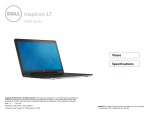Download DELL Latitude 3150
Transcript
Dell Latitude 3150 Owner's Manual Regulatory Model: P21T Regulatory Type: P21T001 Notes, Cautions, and Warnings NOTE: A NOTE indicates important information that helps you make better use of your computer. CAUTION: A CAUTION indicates either potential damage to hardware or loss of data and tells you how to avoid the problem. WARNING: A WARNING indicates a potential for property damage, personal injury, or death. Copyright © 2015 Dell Inc. All rights reserved. This product is protected by U.S. and international copyright and intellectual property laws. Dell™ and the Dell logo are trademarks of Dell Inc. in the United States and/or other jurisdictions. All other marks and names mentioned herein may be trademarks of their respective companies. 2015 - 03 Rev. A00 Contents 1 Working on Your Computer................................................................................5 Before Working Inside Your Computer................................................................................................ 5 Turning Off Your Computer..................................................................................................................6 After Working Inside Your Computer................................................................................................... 7 2 Removing and Installing Components............................................................. 8 Recommended Tools............................................................................................................................8 Removing the Base Cover.....................................................................................................................8 Installing the Base Cover.......................................................................................................................9 Removing the Battery............................................................................................................................9 Installing the Battery............................................................................................................................10 Removing the Audio Board.................................................................................................................10 Installing the Audio Board....................................................................................................................11 Removing the Display Assembly......................................................................................................... 11 Installing the Display Assembly........................................................................................................... 13 Removing the Display Bezel................................................................................................................13 Installing the Display Bezel..................................................................................................................14 Removing the Display Panel................................................................................................................15 Installing the Display Panel................................................................................................................. 16 Removing the Camera........................................................................................................................ 16 Installing the Camera...........................................................................................................................17 Removing the Power-Connector Port............................................................................................... 17 Installing the Power-Connector Port................................................................................................. 18 Removing the Hard-Drive Assembly.................................................................................................. 18 Installing the Hard-Drive Assembly....................................................................................................20 Removing the LED Board.................................................................................................................... 21 Installing the LED Board...................................................................................................................... 21 Removing the Memory........................................................................................................................21 Installing the Memory......................................................................................................................... 22 Removing the Coin-Cell Battery........................................................................................................ 22 Installing the Coin-Cell Battery.......................................................................................................... 23 Removing the Keyboard Trim.............................................................................................................23 Installing the Keyboard Trim...............................................................................................................24 Removing the Keyboard..................................................................................................................... 24 Installing the Keyboard........................................................................................................................25 Removing the WLAN Card..................................................................................................................26 Installing the WLAN Card....................................................................................................................26 Removing the Heatsink.......................................................................................................................26 3 Installing the Heatsink......................................................................................................................... 27 Removing the System Board.............................................................................................................. 28 Installing the System Board................................................................................................................ 29 Removing the Speaker........................................................................................................................ 29 Installing the Speaker..........................................................................................................................30 3 System Setup....................................................................................................... 31 Boot Sequence.................................................................................................................................... 31 Navigation Keys................................................................................................................................... 31 System Setup Options.........................................................................................................................32 Updating the BIOS ............................................................................................................................. 40 System and Setup Password.............................................................................................................. 40 Assigning a System Password and Setup Password.....................................................................41 Deleting or Changing an Existing System and/or Setup Password............................................. 41 4 Technical Specifications................................................................................... 42 5 Diagnostics.......................................................................................................... 47 Enhanced Pre-Boot System Assessment (ePSA) Diagnostics........................................................... 47 Device Status Lights............................................................................................................................48 Battery Status Lights............................................................................................................................49 6 Contacting Dell...................................................................................................50 4 Working on Your Computer 1 Before Working Inside Your Computer Use the following safety guidelines to help protect your computer from potential damage and to help to ensure your personal safety. Unless otherwise noted, each procedure included in this document assumes that the following conditions exist: • You have read the safety information that shipped with your computer. • A component can be replaced or--if purchased separately--installed by performing the removal procedure in reverse order. WARNING: Disconnect all power sources before opening the computer cover or panels. After you finish working inside the computer, replace all covers, panels, and screws before connecting to the power source. WARNING: Before working inside your computer, read the safety information that shipped with your computer. For additional safety best practices information, see the Regulatory Compliance Homepage at www.dell.com/regulatory_compliance CAUTION: Many repairs may only be done by a certified service technician. You should only perform troubleshooting and simple repairs as authorized in your product documentation, or as directed by the online or telephone service and support team. Damage due to servicing that is not authorized by Dell is not covered by your warranty. Read and follow the safety instructions that came with the product. CAUTION: To avoid electrostatic discharge, ground yourself by using a wrist grounding strap or by periodically touching an unpainted metal surface, such as a connector on the back of the computer. CAUTION: Handle components and cards with care. Do not touch the components or contacts on a card. Hold a card by its edges or by its metal mounting bracket. Hold a component such as a processor by its edges, not by its pins. CAUTION: When you disconnect a cable, pull on its connector or on its pull-tab, not on the cable itself. Some cables have connectors with locking tabs; if you are disconnecting this type of cable, press in on the locking tabs before you disconnect the cable. As you pull connectors apart, keep them evenly aligned to avoid bending any connector pins. Also, before you connect a cable, ensure that both connectors are correctly oriented and aligned. NOTE: The color of your computer and certain components may appear differently than shown in this document. To avoid damaging your computer, perform the following steps before you begin working inside the computer. 1. Ensure that your work surface is flat and clean to prevent the computer cover from being scratched. 2. Turn off your computer (see Turning off Your Computer). 5 3. If the computer is connected to a docking device (docked), undock it. CAUTION: To disconnect a network cable, first unplug the cable from your computer and then unplug the cable from the network device. 4. Disconnect all network cables from the computer. 5. Disconnect your computer and all attached devices from their electrical outlets. 6. Close the display and turn the computer upside-down on a flat work surface. NOTE: To avoid damaging the system board, you must remove the main battery before you service the computer. 7. Remove the base cover. 8. Remove the main battery. 9. Turn the computer top-side up. 10. Open the display. 11. Press and hold the power button for few seconds, to ground the system board. CAUTION: To guard against electrical shock, always unplug your computer from the electrical outlet before opening the display. CAUTION: Before touching anything inside your computer, ground yourself by touching an unpainted metal surface, such as the metal at the back of the computer. While you work, periodically touch an unpainted metal surface to dissipate static electricity, which could harm internal components. 12. Remove any installed ExpressCards or Smart Cards from the appropriate slots. Turning Off Your Computer CAUTION: To avoid losing data, save and close all open files and exit all open programs before you turn off your computer. 1. Shut down the operating system: • In Windows 8.1: – Using a touch-enabled device: a. Swipe in from the right edge of the screen, opening the Charms menu and select Settings. b. Select the and then select Shut down. Or * On the Home screen, touch the and then select Shut down. – Using a mouse: a. Point to upper-right corner of the screen and click Settings. b. Click the Or 6 and select Shut down. * • On the Home screen, click and then select Shut down. In Windows 7: 1. Click Start 2. Click Shut Down. . or 2. 1. Click Start 2. Click the arrow in the lower-right corner of the Start menu as shown below, and then click . . Shut Down Ensure that the computer and all attached devices are turned off. If your computer and attached devices did not automatically turn off when you shut down your operating system, press and hold the power button for about 6 seconds to turn them off. After Working Inside Your Computer After you complete any replacement procedure, ensure you connect any external devices, cards, and cables before turning on your computer. CAUTION: To avoid damage to the computer, use only the battery designed for this particular Dell computer. Do not use batteries designed for other Dell computers. 1. Connect any external devices, such as a port replicator or media base, and replace any cards, such as an ExpressCard. 2. Connect any telephone or network cables to your computer. CAUTION: To connect a network cable, first plug the cable into the network device and then plug it into the computer. 3. Replace the battery. 4. Replace the base cover. 5. Connect your computer and all attached devices to their electrical outlets. 6. Turn on your computer. 7 Removing and Installing Components This section provides detailed information on how to remove or install the components from your computer. Recommended Tools The procedures in this document may require the following tools: • Small flat-blade screwdriver • #0 Phillips screwdriver • #1 Phillips screwdriver • Small plastic scribe Removing the Base Cover 1. Follow the procedures in Before Working Inside Your Computer. 2. Perform the following steps to remove the base cover from the computer: a. Remove the screws that secure the base cover to the computer. b. Pry the base cover to release it from the computer. NOTE: You may need a sharp tool to pry the base cover around the edges. 3. 8 Remove the base cover from the computer. 2 Installing the Base Cover 1. Place the base cover to align with the screw holders on the computer. 2. Tighten the screws to secure the base cover to the computer. 3. Follow the procedures in After Working Inside Your Computer. Removing the Battery 1. Follow the procedures in Before Working Inside Your Computer. 2. Remove the base cover. 3. To release the battery from the computer: a. Peel the adhesive tape that secures the battery cable [1]. b. Disconnect the battery cable from its connector on the system board [2]. 4. Perform the following steps: a. Remove the screws that secure the battery to the computer [1]. b. Remove the battery from the computer [2]. 9 Installing the Battery 1. Insert the battery into its place on the computer. 2. Connect the battery cable to its connector on the system board. 3. Fix the adhesive tape to secure the battery cable. 4. Tighten the screws to secure the battery to the computer. 5. Install the base cover. 6. Follow the procedures in After Working Inside Your Computer. Removing the Audio Board 1. Follow the procedures in Before Working Inside Your Computer. 2. Remove the: a. base cover b. battery 3. Perform the following steps: a. Disconnect the audio-board cable from its connector on the system board [1]. b. Remove the screw that secures the audio board to the computer [2]. c. Remove the audio board from the computer [3]. 10 Installing the Audio Board 1. Insert the audio board into its place on the computer. 2. Tighten the screw to secure the audio board to the computer. 3. Connect the audio-board cable to its connector on the system board. 4. Install the: a. battery b. base cover 5. Follow the procedures in After Working Inside Your Computer. Removing the Display Assembly 1. Follow the procedures in Before Working Inside Your Computer. 2. Remove the: a. base cover b. battery 3. To release the display assembly from the computer: a. b. c. d. Disconnect the network cable from its connector on the system board [1]. Remove the screws that secure the metal bracket to the system board [2]. Remove the metal bracket to access the display cable [3]. Disconnect the display cable from its connector on the system board [4]. 11 4. Remove the screws that secure the display hinges to the computer [1] and open the display [2]. 5. Pull the keyboard base assembly away from the display assembly to separate them. 12 Installing the Display Assembly 1. Place the display assembly on the computer chassis. 2. Adjust the display hinges to align with the screw holders on the computer chassis. 3. Tighten the screws to secure the display assembly to the computer. 4. Connect the display cable to its connector on the system board. 5. Place the metal bracket to secure the display cable and tighten the screws to secure the metal bracket. 6. Connect the network cable to its connector on the system board. 7. Install the: a. battery b. base cover 8. Follow the procedures in After Working Inside Your Computer. Removing the Display Bezel 1. Follow the procedures in Before Working Inside Your Computer. 2. Remove the: a. base cover b. battery c. display assembly 3. Perform the following steps: a. Peel the plastic adhesive to access the display-bezel screws [1]. b. Remove the screws that secure the display bezel to the display assembly [2]. 13 4. Pry the edges to release the display bezel [1] and remove the display bezel from the display assembly [2]. Installing the Display Bezel 1. Place the display bezel on the display assembly. 2. Starting from the top corner, press on the display bezel and work around the entire bezel until it snaps on to the display assembly. 3. Tighten the screws to secure the display bezel to the display assembly. 4. Fix the plastic adhesive to secure the display-bezel screws. 5. Install the: a. display assembly 14 b. battery c. base cover 6. Follow the procedures in After Working Inside Your Computer. Removing the Display Panel 1. Follow the procedures in Before Working Inside Your Computer. 2. Remove the: a. base cover b. battery c. display assembly d. display bezel 3. To release the display panel from the display assembly: a. Remove the screws that secure the display panel to the display assembly [1]. b. Lift and flip the display panel to access the eDP cable [2]. 4. Peel the adhesive [1] to access the eDP cable [2]. 15 5. Disconnect the eDP cable from its connector [1] and remove the display panel from the display assembly [2]. Installing the Display Panel 1. Connect the eDP cable to its connector and fix the adhesive tape. 2. Place the display panel to align with the screw holders on the display assembly. 3. Tighten the screws to secure the display panel to the display assembly. 4. Install the: a. b. c. d. 5. display bezel display assembly battery base cover Follow the procedures in After Working Inside Your Computer. Removing the Camera 1. Follow the procedures in Before Working Inside Your Computer. 2. Remove the: a. b. c. d. 3. base cover battery display assembly display bezel To remove the camera from the display assembly: a. Disconnect the camera cable from its connector on the display assembly [1]. b. Pry the camera to remove it from the display assembly [2]. 16 Installing the Camera 1. Insert the camera into its place on the display assembly. 2. Connect the camera cable to its connector on the display assembly. 3. Install the: a. b. c. d. 4. display bezel display assembly battery base cover Follow the procedures in After Working Inside Your Computer. Removing the Power-Connector Port 1. Follow the procedures in Before Working Inside Your Computer. 2. Remove the: a. base cover b. battery c. display assembly 3. Perform the following steps: a. Disconnect the power-connector port cable from its connector on the system board [1]. b. Remove the power-connector port from the computer [2]. 17 Installing the Power-Connector Port 1. Insert the power-connector port into its place on the computer. 2. Connect the power-connector port cable to its connector on the system board. 3. Install the: a. display assembly b. battery c. base cover 4. Follow the procedures in After Working Inside Your Computer. Removing the Hard-Drive Assembly 1. Follow the procedures in Before Working Inside Your Computer. 2. Remove the: a. base cover b. battery 3. Perform the following steps: a. Disconnect the hard-drive cable from its connector on the system board [1]. b. Remove the screws that secure the hard-drive assembly to the computer [2]. 18 4. Remove the hard-drive assembly from the computer. 5. Pull to release the hard-drive cable from its connector on the hard-drive assembly. 19 6. Remove the screws that secure the hard-drive bracket to the hard drive [1] and remove the hard drive from the hard-drive bracket [2]. Installing the Hard-Drive Assembly 1. Place the hard drive within the hard-drive assembly, align the screw holders, and tighten the screws to secure the hard-drive bracket. 2. Connect the hard-drive cable to its connector on the hard drive. 3. Place the hard-drive assembly into its slot on the computer. 4. Connect the hard-drive cable to its connector on the system board. 5. Tighten the screws to secure the hard-drive assembly to the computer. 6. Install the: 20 a. battery b. base cover 7. Follow the procedures in After Working Inside Your Computer. Removing the LED Board 1. Follow the procedures in Before Working Inside Your Computer. 2. Remove the: a. base cover b. battery c. hard-drive assembly 3. Perform the following steps: a. Disconnect the LED board cable from its connector on the system board [1] [2]. b. Remove the screw that secures the LED board to the computer [3]. c. Remove the LED board from the computer [4]. Installing the LED Board 1. Insert the LED board into its place on the computer. 2. Tighten the screw to secure the LED board to the computer. 3. Connect the LED board cable to its connector on the system board. 4. Install the: a. hard-drive assembly b. battery c. base cover 5. Follow the procedures in After Working Inside Your Computer. Removing the Memory 1. Follow the procedures in Before Working Inside Your Computer. 2. Remove the: a. base cover 21 b. battery 3. Pry the clips securing the memory module until the memory pops-up and remove the memory from the system board. Installing the Memory 1. Insert the memory on the memory socket until the clips secure the memory. 2. Install the: a. battery b. base cover 3. Follow the procedures in After Working Inside Your Computer. Removing the Coin-Cell Battery 1. Follow the procedures in Before Working Inside Your Computer. 2. Remove the: a. base cover b. battery 3. Perform the following steps: a. b. c. d. 22 Disconnect the coin-cell battery cable from its connector on the system board [1]. Peel the adhesive tape to release the coin-cell battery cable [2]. Release the coin-cell battery cable from its routing channels [3]. Pry the coin-cell battery to remove it from the computer [4]. Installing the Coin-Cell Battery 1. Insert the coin-cell battery in its place on the computer. 2. Route the coin-cell battery cable along its routing channels. 3. Fix the adhesive tape to secure the coin-cell battery cable. 4. Connect the coin-cell battery cable to its connector on the system board. 5. Install the: a. battery b. base cover 6. Follow the procedures in After Working Inside Your Computer. Removing the Keyboard Trim 1. Follow the steps in Before Working Inside Your Computer. 2. Pry the keyboard trim from its edges. NOTE: You may need a sharp tool to pry the keyboard trim from its edges. 3. Remove the keyboard trim from the keyboard. 23 Installing the Keyboard Trim 1. Insert the keyboard trim to the keyboard until it snaps in its place. 2. Follow the procedures in After Working Inside Your Computer. Removing the Keyboard 1. Follow the procedures in Before Working Inside Your Computer. 2. Remove the: a. battery b. base cover c. keyboard trim NOTE: After removing the keyboard trim, flip the computer to access the keyboard cable. 3. Disconnect the keyboard cable from its connector on the system board [1] [2]. 4. Flip the computer and remove the screws that secure the keyboard to the computer. 24 5. Perform the following steps: a. Pry the keyboard to release it from the computer [1]. b. Remove the keyboard from the computer [2]. Installing the Keyboard 1. Place the keyboard to align with the screw holders on the computer. 2. Flip the computer and connect the keyboard cable to its connector on the system board. 3. Tighten the screws to secure the keyboard to the computer. 4. Install the: a. keyboard trim b. battery c. base cover 5. Follow the procedures in After Working Inside Your Computer. 25 Removing the WLAN Card 1. Follow the procedures in Before Working Inside Your Computer. 2. Remove the: a. base cover b. battery 3. Perform the following steps: a. b. c. d. Remove the screw that secures the metal bracket to the WLAN card [1]. Remove the metal bracket to access the WLAN cables [2]. Disconnect the WLAN cables from their connectors on the WLAN card [3]. Remove the WLAN card from its connector on the system board [4]. Installing the WLAN Card 1. Insert the WLAN card to its connector on the system board. 2. Connect the WLAN cables to their connectors on the WLAN card. 3. Insert the metal bracket to secure the WLAN cables. 4. Tighten the screw to secure the WLAN card to the system board. 5. Install the: a. battery b. base cover 6. Follow the procedures in After Working Inside Your Computer. Removing the Heatsink 1. Follow the procedures in Before Working Inside Your Computer. 2. Remove the: a. base cover b. battery 3. To release the heatsink from the system board: a. Remove the screws that secure the heatsink from the metal bracket [1]. b. Remove the metal bracket from the system board [2]. c. Remove the screw that secures the heatsink to the system board [3]. 26 4. Perform the following steps: a. Remove the screws that secure the heatsink to the system board [1] [2] [3]. b. Remove the heatsink from the system board [4]. Installing the Heatsink 1. Insert the heatsink into its place on the system board. 2. Place the metal bracket and tighten the screws to secure the metal bracket to the system board. 3. Tighten the screws to secure the heatsink to the system board. 4. Install the: a. battery b. base cover 5. Follow the procedures in After Working Inside Your Computer. 27 Removing the System Board 1. Follow the procedures in Before Working Inside Your Computer. 2. Remove the: a. b. c. d. 3. Disconnect the following cables from the system board [1] [2]: a. b. c. d. e. f. g. 4. base cover battery memory heatsink keyboard touchpad LED board network and speaker [3] hard-drive assembly [4] coin-cell battery and power-connector port [5] display [6] Perform the following steps to remove the system board from the computer: a. Remove the screws that secure the system board to the computer [1]. b. Remove the system board from the computer [2]. 28 Installing the System Board 1. Insert the system board into its place on the computer. 2. Tighten the screws to secure the system board to the computer. 3. Connect the following cables to their connectors on the system board: a. b. c. d. e. f. g. 4. Install the: a. b. c. d. 5. display coin-cell battery and power-connector port hard-drive assembly network and speaker LED board touchpad keyboard heatsink memory battery base cover Follow the procedures in After Working Inside Your Computer. Removing the Speaker 1. Follow the procedures in Before Working Inside Your Computer. 2. Remove the: a. b. c. d. e. 3. base cover battery memory heatsink system board Perform the following steps: a. Remove the screws that secure the speaker to the computer [1]. b. Remove the speaker from the computer [2]. 29 Installing the Speaker 1. Insert the speaker into its place on the computer. 2. Tighten the screws to secure the speaker to the computer. 3. Install the: a. b. c. d. e. 4. 30 system board heatsink memory battery base cover Follow the procedures in After Working Inside Your Computer. System Setup 3 System Setup enables you to manage your computer hardware and specify BIOS‐level options. From the System Setup, you can: • Change the NVRAM settings after you add or remove hardware • View the system hardware configuration • Enable or disable integrated devices • Set performance and power management thresholds • Manage your computer security Boot Sequence Boot Sequence allows you to bypass the System Setup‐defined boot device order and boot directly to a specific device (for example: optical drive or hard drive). During the Power-on Self Test (POST), when the Dell logo appears, you can: • Access System Setup by pressing <F2> key • Bring up the one-time boot menu by pressing <F12> key The one-time boot menu displays the devices that you can boot from including the diagnostic option. The boot-menu options are: • Removable Drive (if available) • STXXXX Drive NOTE: XXX denotes the SATA drive number. • Optical Drive • Diagnostics NOTE: Choosing Diagnostics, will display the ePSA diagnostics screen. The boot sequence screen also displays the option to access the System Setup screen. Navigation Keys The following table displays the system setup navigation keys. NOTE: For most of the system setup options, changes that you make are recorded but do not take effect until you re-start the system. 31 Table 1. Navigation Keys Keys Navigation Up arrow Moves to the previous field. Down arrow Moves to the next field. <Enter> Allows you to select a value in the selected field (if applicable) or follow the link in the field. Spacebar Expands or collapses a drop‐down list, if applicable. <Tab> Moves to the next focus area. NOTE: For the standard graphics browser only. <Esc> Moves to the previous page till you view the main screen. Pressing <Esc> in the main screen displays a message that prompts you to save any unsaved changes and restarts the system. <F1> Displays the System Setup help file. System Setup Options NOTE: Depending on your computer and its installed devices, the items listed in this section may or may not appear. Table 2. General Option Description System Information This section lists the primary hardware features of your computer. • • • • System Information Memory Information Processor Information Device Information Battery Information Displays the charge status of the battery. Boot Sequence Allows you to change the order in which the computer attempts to find an operating system. All the options are selected. • • • • • Diskette Drive Internal HDD USB Storage Device CD/DVD/CD-RW Drive Onboard NIC You can also choose the Boot List option. The options are: • • 32 Legacy UEFI Option Description Advanced Boot Options Allows you to enable the Legacy Option ROMs during the UEFI boot mode. This option is enabled by default. Date/Time Allows you to set the date and time. Table 3. System Configuration Option Description Integrated NIC Allows you to configure the integrated network controller. The options are: • • • • Enabled UEFI Network Stack Disabled Enabled Enabled w/PXE (Default Setting) NOTE: This option is disabled by default. If you enable this option, the UEFI Networking Protocols that are available are installed, allowing the pre-OS and the OS networking features to use the enabled NICs. You may have to disable the Enabled w/PXE to use this option. SATA Operation Allows you to configure the internal SATA hard-drive controller. The options are: • • Disabled AHCI (Default Setting) NOTE: SATA is configured to support AHCI mode. Drives Allows you to configure the SATA drives on board. The option is: • • SATA-0 SATA-1 Default Setting: Both drives are enabled. SMART Reporting This field controls if the hard drive errors for the integrated drives are reported during system startup. This technology is part of the SMART (Self Monitoring Analysis and Reporting Technology) specification. • USB Configuration Enable SMART Reporting — This option is disabled by default. Allows you to define the USB configuration. The options are: • Enable Boot Support 33 Option Description • • Enable External USB Port Enable USB 3.0 Controller Default Setting: All the options are enabled. USB PowerShare Allows you to configure the behavior of the USB PowerShare feature. The option is disabled by default. • Audio Enable USB PowerShare Allows you to enable or disable the integrated audio controller. • Miscellaneous Devices Enable Audio (Default Setting) Allows you to enable or disable the various on board devices. The options are: • • • • • Enable Microphone Enable Hard Drive Free Fall Protection Enable Camera Enable Media Card Disable Media Card Default Setting: All devices are enabled. Table 4. Video Option Description LCD Brightness Allows you to set the panel brightness when the ambient sensor is Off. Table 5. Security Option Description Admin Password Allows you to set, change, or delete the administrator (admin) password. NOTE: You must set the admin password first if an admin password is used with a system password and/or hard-drive password NOTE: Successful password changes take effect immediately. NOTE: Deleting the admin password automatically deletes the system password and the hard-drive password. NOTE: Successful password changes take effect immediately. Default Setting: Not set System Password Allows you to set, change or delete the system password. NOTE: Successful password changes take effect immediately. 34 Option Description Default Setting: Not set Internal HDD-0 Password Allows you to set, change, or delete the administrator (admin) password. Default Setting: Not set Strong Password Allows you to enforce the option to always set strong passwords. Default Setting: Enable Strong Password is disabled. Password Configuration You can define the length of your password. Min = 4, Max = 32 Password Bypass Allows you to enable or disable the permission to bypass the System and the Internal HDD password, when they are set. The options are: • • Disabled (Default Setting) Reboot bypass Password Change Allows you to enable the disable permission to the system and hard-drive passwords when the admin password is set. Default Setting: Allow Non-Admin Password Changes is selected. Non-Admin Setup Changes Allows you to determine whether changes to setup option are permitted when an administrator password is set. The option is disabled. • Allows Wireless Switch Changes TPM Security Allows you to control whether the Trusted Platform Module (TPM) in the computer is enabled and visible to the operating system. When you disable this option, the BIOS will not turn on the TPM during POST, and the TPM will be non-functional and invisible to the operating system. When you enable this option, the BIOS will turn on the TPM during POST, and will be functional in the operating system. Default Setting: TPM Security is not selected. Computrace Allows you to activate or disable the optional Computrace software The options are: • • • Deactivate (Default Setting) Disable Activate NOTE: The Activate and Disable options will permanently activate or disable the feature and no further changes will be allowed. CPU XD Support Allows you to enable the Execute Disable mode of the processor. Default Setting: Enable CPU XD Support Admin Setup Lockout Allows you to prevent users from entering Setup when an Administrator password is set. Default Setting: Disabled 35 Table 6. Secure Boot Option Description Secure Boot Enable Allows you to enable or disable the secure boot. The options are: • • Expert Key Management Disabled Enabled (Default Setting) Allows you to manipulate the security key databases only if the system is in Custom Mode. The Enable Custom Mode option is disabled by default. The options are: • • • • PK KEK db dbx If you enable the Custom Mode, the relevant options for PK, KEK, db, and dbx appear. The options are: • • • • • • Save to File–Saves the key to a userselected file Replace from File– Replaces the current key with a key from a userselected file Append from File– Adds a key to the current database from a userselected file Delete– Deletes the selected key Reset All Keys– Resets to default setting Delete All Keys– Deletes all the keys NOTE: If you disable the Custom Mode, all the changes made will be erased and the keys will restore to default settings. Table 7. Performance Option Description C-States Control Allows you to enable or disable the additional processor sleep states. Default Setting: Enable C states. Table 8. Power Management Option Description AC Behavior Allows the computer to power on automatically, when AC adapter is plugged. The option is disabled. 36 Option Description • Auto On Time Allows you to set the time at which the computer must turn on automatically. The options are: • • • • USB Wake Support Disabled (Default Setting) Every Day Weekdays Select Days Allows you to enable the USB devices to wake the computer from standby mode. The option is disabled. • Wireless Radio Control Wake on AC Enable USB Wake Support Allows you to control the WLAN radio. • Control WLAN radio Default Setting: The option is disabled. Wake on LAN/WLAN This option allows the computer to power up from the off state when triggered by a special LAN signal. Wake-up from the Standby state is unaffected by this setting and must be enabled in the operating system. This feature only works when the computer is connected to AC power supply. • • • • Block Sleep Disabled - (Default Setting) LAN Only WLAN Only LAN or WLAN Allows you to block the computer from entering into the sleep state. Option is disabled by default. • Block Sleep (S3) Peak Shift Peak Shift minimizes AC power usage at times of peak demand. Option is disabled by default. Advance Battery Charge Configuration Advanced Battery Charge minimizes battery health while still supporting heavy use during the work day. Option is disabled by default. Primary Battery Charge Configuration Allows you to change the battery charge configuration. • • • • • Adaptive (Default setting) Standard ExpressCharge Primarily AC Use Custom NOTE: Battery settings may not be available for all battery types. To enable this option ‘Advanced Battery Charge Mode’ must be disabled. 37 Table 9. POST Behavior Option Description Adapter Warnings Allows you to activate the adapter warning messages when certain power adapters are used. The option is enabled by default. • Keypad (Embedded) Enable Adapter Warnings Allows you to choose one of two methods to enable the keypad that is embedded in the internal keyboard. • • Fn Key Only (Default Setting) By Numlock Numlock Enable Allows you to enable the Numlock when system boots. The option is enabled by default. Fn Key Emulation Allows you to match the <Scroll Lock> key feature of PS-2 keyboard with the <Fn> key feature in an internal keyboard. The option is enabled by default. • Fn Lock Options Enable Fn Key Emulation This option when enabled allows the hot key combination <Fn> +<Esc> toggle the primary behavior of <F1> – <F12> between their standard and secondary functions. • Fn Lock Hot Key (Default Setting) – Standard (Default Setting) – Secondary Fastboot Allows you to speed up the boot processes. The options are: • • • Extend BIOS POST Time Minimal Thorough - (Default Setting) Auto This option creates an extra pre-boot delay. This allows you to see the POST status messages. • • • 0 seconds (Default Setting) 5 seconds 10 seconds Table 10. Virtualization Support Option Description Virtualization This option specifies whether a Virtual Machine Monitor (VMM) can utilize the additional hardware capabilities provided by Intel Virtualization technology. • 38 Enable Intel Virtualization Technology (Default Setting) Table 11. Wireless Option Description Wireless Switch Allows you to determine which wireless device can be controlled by the wireless switch. The options are: • • Bluetooth WLAN All options are enabled by default. NOTE: For Windows 8.1 Operating System, the Wireless Switch option is directly controlled by the OS driver. So, this setting here does not affect the Wireless Switch Behavior. Wireless Device Enable Allows you to enable or disable the internal wireless devices. The options are: • • Bluetooth WLAN All options are enabled by default. Lid-Mounted Wireless Activity LED This field allows you to control the wireless activity LED mounted on the lid of the system. • • Always Off Led Indicates Wireless Activity (Default Setting) Table 12. Maintenance Option Description Service Tag Displays the Service Tag of your computer. Asset Tag Allows you to create a system asset tag if an asset tag is not already set. This option is not set by default. BIOS Downgrade Allows you to control the flashing of the system firmware to the previous revisions. This option is enabled by default • Allow BIOS Downgrade NOTE: If you disable this option, the flashing of the system firmware to a previous revision will be blocked. Table 13. System Logs Option Description BIOS Events Displays the BIOS event log and allows you to clear the log. • Thermal Events Displays the Thermal event log and allows you to clear the log. • Power Events Clear Log Clear Log Displays the Power event log and allows you to clear the log. • Clear Log 39 Updating the BIOS It is recommended to update your BIOS (system setup), on replacing the system board or if an update is available. For laptops, ensure that your computer battery is fully charged and connected to a power outlet 1. Re-start the computer. 2. Go to dell.com/support. 3. Enter the Service Tag or Express Service Code and click Submit. NOTE: To locate the Service Tag, click Where is my Service Tag? NOTE: If you cannot find your Service Tag, click Detect My Product. Proceed with the instructions on screen. 4. If you are unable to locate or find the Service Tag, click the Product Category of your computer. 5. Choose the Product Type from the list. 6. Select your computer model and the Product Support page of your computer appears. 7. Click Get drivers and click View All Drivers. The Drivers and Downloads page opens. 8. On the Drivers and Downloads screen, under the Operating System drop-down list, select BIOS. 9. Identify the latest BIOS file and click Download File. You can also analyze which drivers need an update. To do this for your product, click Analyze System for Updates and follow the instructions on the screen. 10. Select your preferred download method in the Please select your download method below window, click Download File. The File Download window appears. 11. Click Save to save the file on your computer. 12. Click Run to install the updated BIOS settings on your computer. Follow the instructions on the screen. System and Setup Password You can create a system password and a setup password to secure your computer. Password Type Description System password Password that you must enter to log on to your system. Setup password Password that you must enter to access and make changes to the BIOS settings of your computer. CAUTION: The password features provide a basic level of security for the data on your computer. CAUTION: Anyone can access the data stored on your computer if it is not locked and left unattended. NOTE: Your computer is shipped with the system and setup password feature disabled. 40 Assigning a System Password and Setup Password You can assign a new System Password and/or Setup Password or change an existing System Password and/or Setup Password only when Password Status is Unlocked. If the Password Status is Locked, you cannot change the System Password. NOTE: If the password jumper is disabled, the existing System Password and Setup Password are deleted and you need not provide the system password to log on to the computer. To enter a system setup, press <F2> immediately after a power-on or re-boot. 1. In the System BIOS or System Setup screen, select System Security and press <Enter>. The System Security screen appears. 2. In the System Security screen, verify that Password Status is Unlocked. 3. Select System Password , enter your system password, and press <Enter> or <Tab>. Use the following guidelines to assign the system password: • A password can have up to 32 characters. • The password can contain the numbers 0 through 9. • Only lower case letters are valid, upper case letters are not allowed. • Only the following special characters are allowed: space, (”), (+), (,), (-), (.), (/), (;), ([), (\), (]), (`). Re-enter the system password when prompted. 4. Type the system password that you entered earlier and click OK. 5. Select Setup Password, type your system password and press <Enter> or <Tab>. 6. Type the setup password that you entered earlier and click OK. 7. Press <Esc> and a message prompts you to save the changes. 8. Press <Y> to save the changes. A message prompts you to re-type the setup password. The computer reboots. Deleting or Changing an Existing System and/or Setup Password Ensure that the Password Status is Unlocked (in the System Setup) before attempting to delete or change the existing System and/or Setup password. You cannot delete or change an existing System or Setup password, if the Password Status is Locked. To enter the System Setup, press <F2> immediately after a power-on or reboot. 1. In the System BIOS or System Setup screen, select System Security and press <Enter>. The System Security screen is displayed. 2. In the System Security screen, verify that Password Status is Unlocked. 3. Select System Password, alter or delete the existing system password and press <Enter> or <Tab>. 4. Select Setup Password, alter or delete the existing setup password and press <Enter> or <Tab>. NOTE: If you change the System and/or Setup password, re-enter the new password when promoted. If you delete the System and/or Setup password, confirm the deletion when promoted. 5. Press <Esc> and a message prompts you to save the changes. 6. Press <Y> to save the changes and exit from the System Setup. The computer reboots. 41 Technical Specifications 4 NOTE: Offerings may vary by region. The following specifications are only those required by law to ship with your computer. For more information about the configuration of your computer, go to Help and Support in your Windows operating system and select the option to view information about your computer. System Information Chipset Intel Bay Trail-M (Integrated with the processor) Processor Type • • Intel Pentium Intel Celeron Video Video type Integrated on system board Data bus Integrated video Video controller: Intel Pentium Intel Celeron Intel Integrated HD Graphics Memory Memory connector One SODIMM slot Memory capacity 2 GB, 4 GB, and 8 GB Memory type 1333 MHz DDR3L Minimum memory 2 GB Maximum memory 8 GB Audio Type Two-channel high definition audio Controller Realtek ALC3234–CG Controller Stereo Conversion 24-bit (analog-to-digital and digital-to-analog) Interface: 42 Internal High-definition audio External Microphone-in/stereo headphones combo connector Audio Speakers Two (2W per channel) Internal speaker amplifier Two (2W per channel) Volume controls Software program menus, media controls, and keyboard function keys Communications Network adapter 10/100/1000 Mbps Ethernet LAN Wireless • • Intel Dual Band Wireless- 7265 802.11AC Wi-Fi + BT 4.0 LE Wireless Card (2x2) Intel Dual Band Wireless- 7265 802.11AGN Wi-Fi + BT 4.0 LE Wireless Card (2x2) Ports and Connectors Audio Audio In / Out one Combo Jack Video One 19–pin HDMI connector Network adapter One RJ-45 network adapter USB • • Memory card reader SD 3.0 Memory-card reader One USB 2.0 compliant connectors One USB 3.0 PowerShare connector Camera Resolution 1280 x 720 pixels Video Resolution (maximum) 1280 x 720 pixels Diagonal viewing angle 74 ° Display Type Non-Touch HD Anti-Glare Size 11.60 inches Active area (X/Y) 256.12 mm x 144.00 mm (10.08 inches x 5.67 inches) Dimensions: Height 168.50 mm (6.63 inches) Width 268.50 mm (10.57 inches) Maximum resolution 1366 x 768 pixels at 262 K colors Maximum Brightness 220 nits Refresh rate 60 Hz Operating Angle 0° (closed) to 187.5° Minimum Viewing Angles: 43 Display Horizontal HD +40/- 40 degrees Vertical HD +10/-30 degrees Pixel pitch 0.2148 mm x 0.2148 mm Keyboard Number of keys • • • United States and Canada: 82 keys Europe and Brazil: 83 keys Japan: 86 keys Touchpad Active Area: X-axis 102.40 mm (4.03 inches) Y-axis 57.40 mm (2.26 inches) Battery Type 3-cell Li-polymer (3.43 AHr) (38 Whr) Dimensions: Depth: 3-cell 233.00 mm (9.17 inches) 3-cell 7.05 mm (0.28 inch) 3-cell 94.80 mm (3..73 inches) Height: Width: Weight: 3-cell 265.00 g (0.58 lb) Voltage: 3-cell Approximate charge time of battery with computer off (ExpressCharge) 11.1 VDC • • • 0~15 °C: 4 hours 16~45 °C: 2 hours 46~60 °C: 3 hours Temperature range: Operating 0 °C to 35 °C (32 °F to 95 °F) Non-operating –40 °C to 65 °C (–40 °F to 149 °F) Coin-cell battery 44 3 V CR2032 lithium ion AC Adapter Type 65W 65W HF-free 65W Non-HF free 90W (India only) Input voltage 100 VAC to 240 VAC 100 VAC to 240 VAC 100 VAC to 240 VAC 100 to 240 VAC Input current (maximum) 1.70 A 1.70 A 1.70 A 2.5 A Input frequency 50 Hz to 60 Hz 50 Hz to 60 Hz 50 Hz to 60 Hz 50 Hz to 60 Hz Output current 3.34 A (continuous) 3.34 A (continuous) 3.34 A (continuous) 4.62 A (continuous) Rated output voltage 19.50 VDC 19.50 VDC 19.50 VDC 19.5 VDC Height 22.00 mm (0.87 inch) 28.00 mm (1.10 inches) 28.00 mm (1.10 inches) 32.00 mm (1.30 inches) Width 66.00 mm (2.60 inches) 47.00 mm (1.90 inches) 47.00 mm (1.90 inches) 52.00 (2.00 inches) Depth 106.00 mm (4.17 inches) 108.00 mm (4.30 inches) 108.00 mm (4.30 inches) 128.00 (5.00 inches) Dimensions: Temperature range: Operating Non Operating 0 °C to 40 °C (32 °F to 104 °F) –40 °C to 70 °C (–40 °F to 158 °F) Physical Height (with a WLED panel) 22.90 mm (0.90 inch) Width 301.00 mm (11.85.0 inches) Depth 212.00 mm (8.35 inches) Weight (Minimum) 1.68 kg (3.70 lb) Environmental Temperature range: Operating 5 °C to 60 °C (41 °F to 140 °F) Storage -40 °C to 65 °C (–40 °F to 149 °F) Relative humidity (maximum): Operating 10 % to 90 % (non-condensing) Storage 5 % to 95 % (non-condensing) Altitude (maximum): Operating –15.2 m to 3048 m (–50 to 10,000 ft) 0° C to 35°C Non-Operating -15.20 m to 10,668 m (-50 ft to 35,000 ft) 45 Environmental Maximum vibration: Operating 0.66 Grms (2 Hz - 600 Hz) Storage 1.30 Grms (2 Hz - 600 Hz) Maximum shock: Operating 110 G Storage 160 G Airborne contaminant level 46 G1 or lower as defined by ISA-S71.04–1985 Diagnostics 5 If you experience a problem with your computer, run the ePSA diagnostics before contacting Dell for technical assistance. The purpose of running diagnostics is to test your computer's hardware without requiring additional equipment or risking data loss. If you are unable to fix the problem yourself, service and support personnel can use the diagnostics results to help you solve the problem. Enhanced Pre-Boot System Assessment (ePSA) Diagnostics The ePSA diagnostics (also known as system diagnostics) performs a complete check of your hardware. The ePSA is embedded with the BIOS and is launched by the BIOS internally. The embedded system diagnostics provides a set of options for particular devices or device groups allowing you to: • Run tests automatically or in an interactive mode • Repeat tests • Display or save test results • Run thorough tests to introduce additional test options to provide extra information about the failed device(s) • View status messages that inform you if tests are completed successfully • View error messages that inform you of problems encountered during testing CAUTION: Use the system diagnostics to test only your computer. Using this program with other computers may cause invalid results or error messages. NOTE: Some tests for specific devices require user interaction. Always ensure that you are present at the computer terminal when the diagnostic tests are performed. You can launch the ePSA diagnostics by two ways: 1. Power-on the computer. 2. As the computer boots, press the <F12> key as the Dell logo appears. 3. On the boot menu screen, select the Diagnostics option. The Enhanced Pre-boot System Assessment window displays, listing all devices detected in the computer. The diagnostics starts running the tests on all the detected devices. 4. If you wish to run a diagnostic test on a specific device, press <Esc> and click Yes to stop the diagnostic test. 5. Select the device from the left pane and click Run Tests 6. If there are any issues, error codes are displayed. Note the error code and contact Dell. OR 47 1. Shutdown the computer. 2. Press and hold the <fn> key, while pressing the power button, and then release both. The Enhanced Pre-boot System Assessment window displays, listing all devices detected in the computer. The diagnostics starts running the tests on all the detected devices. 3. On the boot menu screen, select the Diagnostics option. The Enhanced Pre-boot System Assessment window displays, listing all devices detected in the computer. The diagnostics starts running the tests on all the detected devices. 4. If you wish to run a diagnostic test on a specific device, press <Esc> and click Yes to stop the diagnostic test. 5. Select the device from the left pane and click Run Tests 6. If there are any issues, error codes are displayed. Note the error code and contact Dell. Device Status Lights Table 14. Device Status Lights Turns on when you turn on the computer and blinks when the computer is in a power management mode. Turns on when the computer reads or writes data. Turns on steadily or blinks to indicate battery charge status. Turns on when wireless networking is enabled. The device status LEDs are usually located either on the top or left side of the keyboard. They display the storage, battery and wireless devices connectivity and activity. Apart from that they can be useful as a diagnostic tool when there's a possible failure to the system. The following table lists how to read the LED codes when possible errors occur. Table 15. LED Lights Storage LED Power LED Wireless LED Fault Description Blinking Solid Solid A possible processor failure has occurred. Solid Blinking Solid The memory modules are detected but encountered an error. Blinking Blinking Blinking A system board failure has occurred. Blinking Blinking Solid A possible graphics card/video failure has occurred. Blinking Blinking Off System failed on hard drive initialization OR System failed in Option ROM initialization. Blinking Off Blinking The USB controller encountered a problem during initialization. Solid Blinking Blinking No memory modules are installed/detected. 48 Storage LED Power LED Wireless LED Fault Description Blinking Solid Blinking The display encountered a problem during initialization. Off Blinking Blinking The modem is preventing the system from completing POST Off Blinking Off Memory failed to initialize or memory is unsupported. Battery Status Lights If the computer is connected to an electrical outlet, the battery light operates as follows: Alternately blinking amber light and white light An unauthenticated or unsupported non-Dell AC adapter is attached to your laptop. Alternately blinking amber light with steady white light Temporary battery failure with AC adapter present. Constantly blinking amber light Fatal battery failure with AC adapter present. Light off Battery in full charge mode with AC adapter present. White light on Battery in charge mode with AC adapter present. 49 Contacting Dell 6 NOTE: If you do not have an active Internet connection, you can find contact information on your purchase invoice, packing slip, bill, or Dell product catalog. Dell provides several online and telephone-based support and service options. Availability varies by country and product, and some services may not be available in your area. To contact Dell for sales, technical support, or customer service issues: 1. Go to dell.com/support. 2. Select your support category. 3. Verify your country or region in the Choose a Country/Region drop-down list at the bottom of the page. 4. Select the appropriate service or support link based on your need. 50







































































